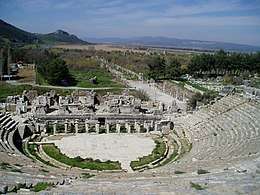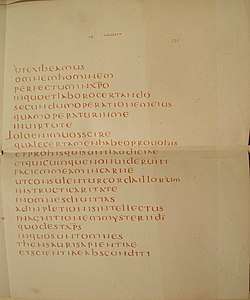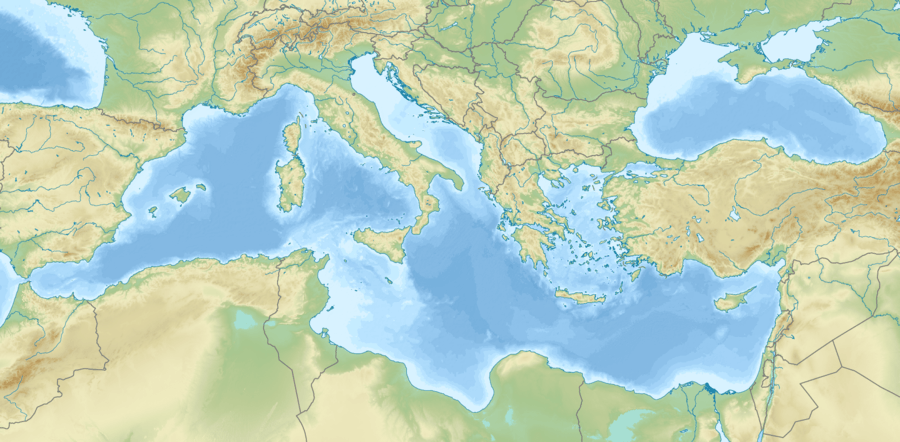Colossians 1
Colossians 1 is the first chapter of the Epistle to the Colossians in the New Testament of the Christian Bible. Traditionally, it is believed to be written for the church in Colossae by Apostle Paul, with Timothy as his co-author, while he was in prison in Ephesus (years 53-54), although there were debatable charges that it is the work of a secondary imitator or that it was written in Rome (in early 60s).[1] This chapter contains the greeting, thanksgiving and prayer, followed by a "Christological Hymn" and the thesis of the letter.[2]
| Colossians 1 | |
|---|---|
 A page showing the Greek text of Epistle to the Colossians 1:28-2:3 on Codex Claromontanus from ca. AD 550. | |
| Book | Epistle to the Colossians |
| Category | Pauline epistles |
| Christian Bible part | New Testament |
| Order in the Christian part | 12 |

Text

The original text was written in Koine Greek. This chapter is divided into 29 verses.
Textual witnesses
Some early manuscripts containing the text of this chapter are:
- Papyrus 46 (c. AD 200)
- Codex Vaticanus (325-350)
- Codex Sinaiticus (330-360)
- Codex Alexandrinus (400-440)
- Codex Ephraemi Rescriptus (c. 450; extant verses 3-29)
- Codex Freerianus (c. 450; extant verses 1:1-4, 10-12, 20-22, 27-29)
- Codex Claromontanus (c. 550; in Greek and Latin)
- Codex Coislinianus (c. 550; extant verses 26-29)
Greeting (1:1–2)
.jpg)
Verse 1
The mention of Timothy alone among the fellow believers who were with Paul at that time (Colossians 4:7-14) suggests that he was the co-author of this epistle.[4]
Verse 2
- To the saints and faithful brethren in Christ who are in Colosse:
- Grace to you and peace from God our Father and the Lord Jesus Christ.[5]
Paul's opening greeting in his epistles normally mentions "a double source of divine benefactions: 'from God our/the Father and the Lord Jesus Christ'.[4] The omission of the second element[lower-alpha 1] may be due to the presence of 'in Christ' in the first part of this verse.[7]
Thanksgiving (1:3–8)
In most of his letters,[lower-alpha 2] Paul follows the greeting with a thanksgiving to God for his recipients, which "carefully reflect Paul's assessment to the state of the community, and reveal his concerns".[4] The information about the believers at Collosae was obtained from Epaphras (Colossians 1:4,8),[8] who was also from Collosae (Colossians 4:12).[9]
Prayer for the Future (1:9–11)
The believers have been the object of Paul's constant concern, so he asks God to make them understand his will, do good works and persevere.[8]
Conversion (1:12–14)
This section is actually still within one unbroken sentence with the previous, but in here Paul describes the crucial conversion of the believers into the form displayed by Christ, that is "by incorporation into Christ in baptism, the structures of the world are replaced by new values".[8]
The Christological Hymn (1:15–20)
A pattern of a 'Christological Hymn' in verses 15–20 has been hinted multiple times in the past without any hypothesis getting significant support.[8] Jerome Murphy-O'Connor offers a reconstruction that shows "two four-line strophes" as follows:[8]
| Verse | Line | Text |
|---|---|---|
| 1:15a | [1] | Who is (the) image of the invisible God |
| 1:15b | [2] | Firstborn of all creation |
| 1:16a | [3] | For in him were created all things |
| 1:16b | [4] | All things through him and to him were created. |
| 1:18b | [1] | Who is (the) beginning |
| 1:18c | [2] | Firstborn from the dead |
| 1:19 | [3] | For in him was pleased all the Fullness to dwell |
| 1:20a | [4] | And through him to reconcile all things to him. |
Verse 15
- He is the image of the invisible God, the firstborn over all creation.[10]
Verse 16
- For by Him all things were created that are in heaven and that are on earth, visible and invisible, whether thrones or dominions or principalities or powers.
- All things were created through Him and for Him.[11]
Verse 17
- And He is before all things, and in Him all things consist.[12]
Verse 18
- And He is the head of the body, the church, who is the beginning, the firstborn from the dead, that in all things He may have the preeminence.[13]
Verses 19–20
- 19For it pleased the Father that in Him all the fullness should dwell, 20and by Him to reconcile all things to Himself, by Him, whether things on earth or things in heaven, having made peace through the blood of His cross.[14]
The Thesis of the Letter (1:21—23)
The three verses in this part enunciate the major themes of the epistle.[15]
Servant of the Mystery (1:24-2:5)
This section continues to chapter 2, dealing with Paul's sufferings which "reveal the present reality of grace" as a member of the body of Christ.[16]
Verses 24–26
- 24I now rejoice in my sufferings for you, and fill up in my flesh what is lacking in the afflictions of Christ, for the sake of His body, which is the church, 25of which I became a minister according to the stewardship from God which was given to me for you, to fulfill the word of God, 26the mystery which has been hidden from ages and from generations, but now has been revealed to His saints.[17]
- "Fill up in my flesh what is lacking in the afflictions of Christ": Murphy-O'Connor prefers a more literal translation as given by Aletti: "I complete what is lacking in the sufferings-of-Christ-in-my-flesh" (cf. Galatians 2:20; 2 Corinthians 4:10-11) with no reference to the "individual Jesus Christ", because Paul's sufferings is due to him being a member of Christ's body (cf. Philippians 3:10).[18]
See also
- Colosse
- Epaphras
- Jesus Christ
- Paul of Tarsus
- Timothy
- Related Bible parts: Acts 9, 2 Corinthians 1, 2 Corinthians 4, 2 Corinthians 11, Philippians 3
Notes
- The absence of the phrase 'and the Lord Jesus Christ' is notable in Codex Vaticanus. Codex Sinaiticus, Byzantine Majority Text and Textus Receptus all have the complete phrase, whereas Codex Alexandrinus omits 'the Lord'.[6]
- Only the Epistle to the Galatians, 1 Timothy and Titus don't contain the thanksgiving section after the greeting.[4]
References
- Murphy-O'Connor 2007, p. 1191–1192.
- Murphy-O'Connor 2007, p. 1192–1194.
- Colossians 1:1 NKJV
- Murphy-O'Connor 2007, p. 1192.
- Colossians 1:2 NKJV
- N-A28 Apparatus on Colossians 1:2; Greek text analysis on Colossians 1:2 at Biblehub.com
- Aletti, J.-N. (1993) Saint Paul: Epitre aux Colossiens, Ebib NS 20 (Paris: Gabalda) p. 46; apud Murphy-O'Connor 2007, p. 1192.
- Murphy-O'Connor 2007, p. 1193.
- Moo, Douglas J. (2008). The Letters to the Colossians and to Philemon. Grand Rapids: William B. Eerdmans Publishing Company. p. 90. ISBN 9781844743414.
- Colossians 1:15 NKJV
- Colossians 1:16 NKJV
- Colossians 1:17 NKJV
- Colossians 1:18 NKJV
- Colossians 1:19–20 NKJV
- Murphy-O'Connor 2007, p. 1194.
- Murphy-O'Connor 2007, p. 1195.
- Colossians 1:24-26 NKJV
- Aletti, J.-N. (1993) Saint Paul: Epitre aux Colossiens, Ebib NS 20 (Paris: Gabalda), p. 135; apud Murphy-O'Connor 2007, p. 1195
Bibliography
- Murphy-O'Connor, Jerome (2007). "70. Colossians". In Barton, John; Muddiman, John (eds.). The Oxford Bible Commentary (first (paperback) ed.). Oxford University Press. pp. 1191–1199. ISBN 978-0199277186. Retrieved February 6, 2019.
External links
- Colossians 1 King James Bible - Wikisource
- English Translation with Parallel Latin Vulgate
- Online Bible at GospelHall.org (ESV, KJV, Darby, American Standard Version, Bible in Basic English)
- Multiple bible versions at Bible Gateway (NKJV, NIV, NRSV etc.)
